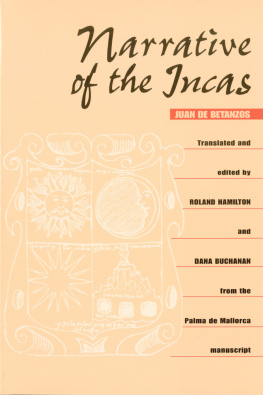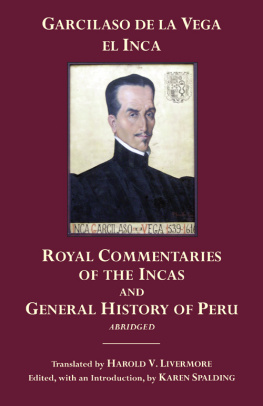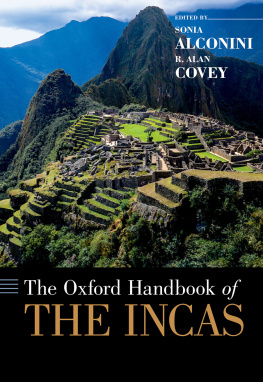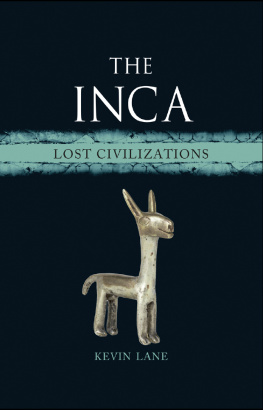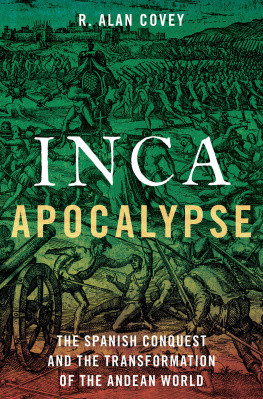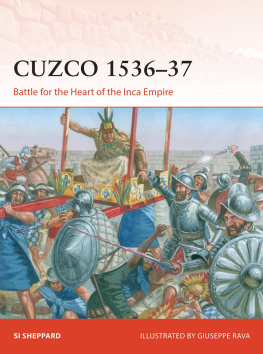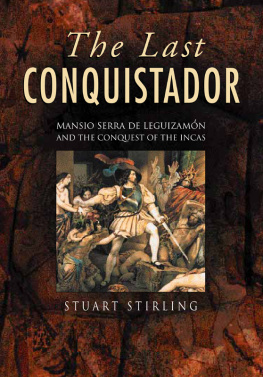Narrative of the Incas
Narrative of the Incas
by
JUAN DE BETANZOS
Translated and edited by
Roland Hamilton and Dana Buchanan
from the Palma de Mallorca manuscript

UNIVERSITY OF TEXAS PRESS
Austin
Copyright 1996 by the University of Texas Press
All rights reserved
Printed in the United States of America
Third paperback printing, 2006
Requests for permission to reproduce material from this work should be sent to Permissions, University of Texas Press, Box 7819, Austin, TX 78713-7819.
utpress.utexas.edu/about/book-permissions
LIBRARY OF CONGRESS CATALOGING-IN-PUBLICATION DATA
Betanzos, Juan de, d. 1576.
[Suma y narracin de los incas. English]
Narrative of the Incas / by Juan de Betanzos ; translated and edited by Roland Hamilton and Dana Buchanan from the Palma de Mallorca manuscript.
p. cm.
Includes bibliographical references and index.
ISBN-13: 978-0-292-75560-4 (cloth)
ISBN-10: 0-292-75560-0 (cloth)
ISBN-13: 978-0-292-75559-8 (paper)
ISBN-10: 0-292-75559-7 (paper)
1. IncasHistory. 2. PeruHistoryConquest, 15321548. 3. Indians of South AmericaAndes RegionHistory. I. Hamilton, Roland, 1936 . II. Buchanan, Dana, 1939 . III. Title.
F3429.B5413 1996
985.02dc20 95-42695
ISBN 978-0-292-75636-6 (e-book)
ISBN 978-0-292-79190-9 (individual e-book)
INTRODUCTION
Juan de Betanzos and Inca Traditions
Juan de Betanzos was born in Spain but spent his adult life in the Viceroyalty of Peru. By far the most important source of information about him comes from his only remaining work, originally entitled Suma y narracin de los Yngas... , which has been abbreviated in English translation. In 1557 Juan de Betanzos finished his Narrative of the Incas, who only had a primary school education. However, as Betanzos explains in his introductory letter, his style was affected by the fact that he was translating his material, and he tried to do as literal a translation from his informants Quechua as possible.
Juan de Betanzos became the most respected Quechua interpreter of the Viceroyalty of Peru. It took him several years to learn the Quechua language with no dictionaries, grammars, or textbooks. In his shows what a formidable task Betanzos undertook in pioneering the translation of Christian concepts foreign to the Quechua language.
Some time after 1541, when Francisco Pizarro was assassinated, Juan de Betanzos married Doa Angelina Yupanque. At birth, she was taken to her uncle, the Inca Huayna Capac, who expressed his joy by calling her his mother.
Marriage to Angelina meant instant wealth for Betanzos because she had extensive land grants and property in the Cuzco area. Their daughter, Maria, married in Cuzco. Doa Angelina and her family provided Betanzos with his major source of information on Inca traditions. Though the Betanzos narrative reflects the brilliant memory of his wife and family, no one, not even Betanzos, ever told what she looked like or how she acted. This great woman, married to the last Inca king, taken as part of the plunder by the conquistador Pizarro, and used for her collective memory of the Inca saga, comes down to us as a shadowy figure behind the glitter of the men in her life.
In 1551 Viceroy Antonio de Mendoza ordered Betanzos to prepare an account of Inca history and traditions. Betanzos indicates that he had finished at least up through Betanzos asked to accompany an embassy to negotiate with the Inca Sayre Topa, head of the neo-Inca state northwest of Cuzco. The viceroy granted the request, and Betanzos spent several months trying to convince the Inca to come back under Spanish rule. Since Betanzos ended his Narrative shortly before going on this embassy, one must read other sources to find out how Inca Sayre Topa came to Lima, got a warm reception from the viceroy, and settled in Cuzco.
Evidently, Betanzos received some compensation for translating Christian doctrine, recording Inca traditions, and acting as interpreter. Although he gives no details about how much he was paid, the tone of his introductory letter to the viceroy is more that of a paid official than of an independent scholar. His insistence on how long and hard he would have to work to translate an authentic account of Inca history and traditions sounds like justification for a handsome honorarium. He seems to have preferred working as an interpreter, however, because he requested that the viceroy grant him a place with the embassy to Sayre Topa rather than seeking another job translating. After this assignment as an interpreter, Betanzos appears to have spent the rest of his life in Cuzco.
Betanzos divided Narrative of the Incas into two parts. , where Betanzos quotes Pachacuti giving instructions for his own funeral and making up a song about himself.
Pachacuti comes forth as a culture hero who defended Cuzco against overwhelming odds, successfully set out on military expeditions of conquest, and established the system of government, laws, city planning, and many of the Inca religious rites ().
).
Doa Angelina, who, as a child of ten, spent the months after the conquest in 1532 in Atahualpas camp, remembered the Incas reactions to the Spaniards, their concern about whether the Spaniards were viracocha gods or mere men, whether they should be attacked, Atahualpas treatment as a prisoner, and his death ().
Betanzos gives no indication that he aspired to publish his work. He did not even bother to update the introductory letter of 1551 or to add a letter to the new viceroy in 1557. Presumably, someone took the work back to Spain, but no one mentions it until Father Gregorio Garcia states in his work on the origin of the Indians (published in 1607) that he found Betanzos very valuable for Inca traditions. Mara del Carmen Martn Rubio edited the first Spanish edition of this manuscript with the Editorial Atlas (Madrid, 1987).
Unfortunately, this Atlas edition contains many transcription errors. For example, the word apa always appears in the Palma manuscript with the (see folio 64v, line 33, ).
The colloquial style of the Narrative suggests that Betanzos spoke with his informants in Quechua and then dictated his account to a scribe. This account was transcribed in the Palma manuscript with the regular lettering of an early ). Punctuation marks and paragraphs have been used in the English translation to make it more readable.
Careful study of the Betanzos Narrative adds many insights into Inca history and traditions. For example, there has long been a controversy over Inca chronology.
Inca marriage customs have often been debated, especially marriage of the Inca rulers to their full sisters. The Betanzos Narrative indicates that the tenth Inca, Topa, was the first to marry his sister, Mama Ocllo. Whether she was his full or half-sister is not clarified. Topas successor, Huayna Capac, seems to have done the same. However, Huayna Capac appears to be the only Inca ruler who came from the union of brother and sister. He arranged the marriage of Atahualpa to a cousin, Cuxirimay (see ). Since Cuxirimay was only ten when the marriage took place, just before Atahualpas installation as Inca in 1532, the union was probably never consummated and was more ceremonial than anything else. It suggests that Topa Incas and Huayna Capacs marriages to sisters may also have been mainly ceremonial. All the Incas had numerous secondary wives for their sexual pleasure.
The Betanzos Narrative gives many other details about rites performed at
Betanzos spins a dramatic and complex tale of revenge during the conquest period mainly from the point of view of the Incas. After the sudden death of Huayna Capac, the bitter civil war between his sons Huascar and Atahualpa emerges as a test of honor rivaling that of the proudest Spaniard. For example, Atahualpas emissary of goodwill strikes Huascar as a traitor, so Huascar has him skinned and a drum made of his hide. Huascars mother tries to no avail to keep the peace. After Atahualpas generals win the war, he has Huascars whole family killedmen, women, and children. Pregnant women have their wombs opened and their unborn children stripped from their bodies ().
Next page
